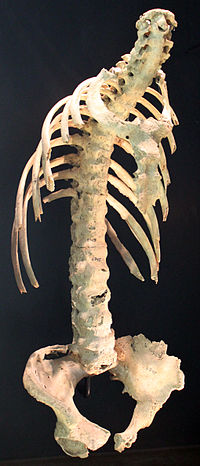
Photo from wikipedia
Purpose: Tadalafil’s exact analgesic mechanism is still unclear. The current study aimed to elucidate this mechanism in an inflammatory pain model. Methods: Computer-assisted simulation docking experiments were carried out to… Click to show full abstract
Purpose: Tadalafil’s exact analgesic mechanism is still unclear. The current study aimed to elucidate this mechanism in an inflammatory pain model. Methods: Computer-assisted simulation docking experiments were carried out to assess the binding of tadalafil to different ligands. The anti-inflammatory and analgesic effects of tadalafil were evaluated using formalin-induced paw edema and a von Frey filament test, respectively. The plantar paw of the mice was then dissected to quantify iNOS, nNOS, COX-2, TNFα, IL1, and IL10 gene expression levels using a real-time polymerase chain reaction. iNOS, TNFα, and COX-2 inhibition was reassessed in vitro using the ELISA technique. One-way analysis of variance followed by post hoc Tukey test or t-test was used to compare the means. Results: Docking analysis showed a superior binding score of tadalafil to COX-2, iNOS, IL-1, and TNF-α compared to that of indomethacin and morphine and a similar binding score to nNOS and IL-10 relative to that of indomethacin. In the in vivo study, tadalafil, after an hour of formalin administration, inhibited significantly paw edema, similar to indomethacin. Furthermore, it significantly increased the withdrawal force in the von Frey filament test as compared to the negative control, which was similar to the effect observed with indomethacin and morphine. The RT-PCR revealed that tadalafil reduced significantly the iNOS, COX-2, and TNF-α gene expressions but had no effect on nNOS, IL 1, and IL10. In vitro ELISA tests confirmed the inhibition of iNOS, COX-2, and TNF-α. Conclusion: Tadalafil probably exerts its analgesic effect through the simultaneous inhibition of iNOS, COX-2, and TNF-α, which is not the case with other nonsteroidal anti-inflammatory drugs. Nevertheless, further studies are required to confirm its mechanism.
Journal Title: ACS Omega
Year Published: 2022
Link to full text (if available)
Share on Social Media: Sign Up to like & get
recommendations!